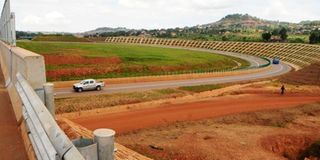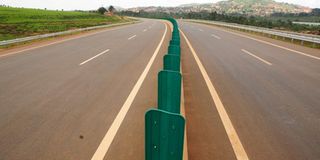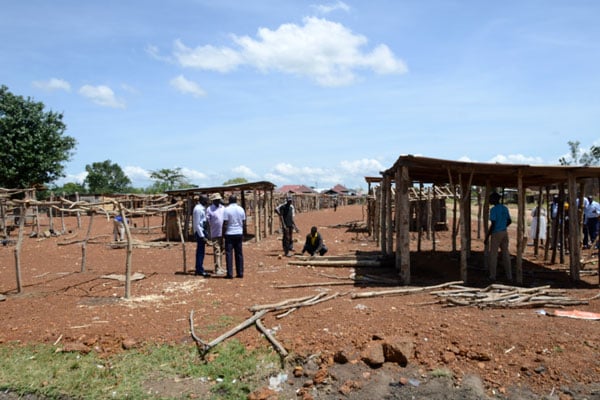Paying the price for delayed works on Northern Bypass, Entebbe Expressway

A section of the Entebbe - Kampala Expressway. File photo
What you need to know:
Counting the cost. Construction of the Kampala-Entebbe Expressway and expansion of the Northern Bypass can be said to be complete at various sections. However, the initial completion dates for the two, which cost an estimated Shs2 trillion, have since been deferred to May and June 2018 respectively, owing to the burdensome land compensations. For the Entebbe Expressway the rescheduling, Uganda could pay an extra price, writes Frederic Musisi.
China Construction Communication Company (CCCC), which is constructing the 51.4km Kampala-Entebbe Expressway, has tendered to government at least 24 claims of costs for idle time on the project site.
Idle time is time for which an employee/contractor is paid but for which they are not doing actual work. This can be categorised as either normal, as a result of uncontrollable factors or abnormal, owing to controllable factors.
One of the claim, according to people familiar with the matter, is for no work done between May 29 and June 2 last year when President Museveni hosted former South Korean President Park Geun-Hye and Turkey’s Recep Tayyip Erdogan.
The country’s only airport, Entebbe International Airport, was half closed and the main road cordoned off for the dignitaries while the rest of the population were advised to use tributary roads to and from Entebbe, including the new expressway whose initial completion date was November 2017.
Construction of the four-lane toll highway commenced in November 2012 at a reported cost of $476m (about Shs1.7 trillion) secured from China’s Exim Bank, which is also financing the government’s other infrastructure projects. If, subject to protracted valuations, the claims are accepted, it would mean an extra price to the original cost.
The remaining claims for costs in idle time, sources said, are as a result of delays caused by the slow acquisition of land by UNRA at various points. For example, since 2015, construction of the section at Nakilagala, Ssisa Sub-county in Wakiso, came to standstill over land disputes between former Nakawa Division Mayor Benjamin Kalumba and Madhvani Group Limited. This was worsened by the caveat that court had slapped on the land in question, so UNRA could not proceed to compensate any of the two parties.

Expansion. Part of the Northern Bypass road under construction.
Compensation headaches
In another case, construction came to a standstill for almost a year at Bandwe, after one land owner demanded payment of Shs48b before CCCC and UNRA could blast a rock sitting on his land through which the road was aligned. Stuck between a rock and hard place – to either pay Shs48b or the initially assessed Shs2b, UNRA was forced to instead alter the initial project designs to sidestep the rock.
During a recent tour of the road, officials from Beijing Engineering Service (BES) and CCCC, the contractor, said the matter of delay claims is “above them” but affirmed that the initial project cost of $476m still stands.
UNRA project manager Hassan Semanda confirmed that CCCC has made some claims and although none has been approved, it is a subject that will be discussed once ongoing works are completed and the road commissioned. May 2018 is the new completion date.
Mr Semanda, however, revealed that a “cost free” extension of 169 days was agreed upon in principle between CCCC and the roads authority.
According to the findings contained in a report by the Parliamentary Commission on Statutory Authorities and State Enterprises (Cosase), which was probing the roads body last year, the unit cost of a kilometre of the road is $9.2m (Shs32b) over the average $2 million.
“Currently, we can say that 80 per cent of the project is complete,” Mr Semanda said, adding that “our mission is to ensure that we squeeze the remaining 20 per cent works in those days.”
The biggest setback, as experienced on all other road projects, is the burdensome acquisition of the proposed right of way and compensations. To make matters worse, currently there is no money for the exercise pending releases in the first quarter of this financial year.
UNRA records show that there were about 4,535 Project Affected Persons (PAPs) evaluated for compensation. Of these, 3,100 have been paid so far but compensation of the remaining 1,435 hangs in balance.
What complicates the situation further is that most remaining PAPs are located along the heavily built and urbanised section between the area of the proposed interchange at Impala through Nkumba, Abayita Ababiri, Kitubulu Katabi to the State House area along the old Entebbe road, which section is going to be widened.
“I cannot tell you how much is required in total because we have both new and old cases to deal with,” Mr Semanda said.
By observation, it is true most parts of Entebbe Expressway are complete. The road boasts of 19 over bridges/flyovers and 17 underpasses (section of road that passes under another road with a total length of 2,770 metres, including the Nambigirwa Bridge measuring approximately 1.45km, the longest four-lane bridge so far in East Africa.
It has three toll gates at Busega, Kajjansi and Abayita whose construction is nearly complete. Mr Semanda said they are in process of acquiring a toll management operator who will work closely with CCCC in the first two years. No toll fee has yet been fixed but a toll policy is currently before Parliament.
The road runs from Impala, on the old Entebbe road through Sisa, Kajjansi, Kabojja to Busega on the outskirts of Kampala where it connects from the Northern Bypass. From Kajjansi, the road has a 14km spur route to Munyonyo, which is [not] yet complete owing to some geological challenges and compensation problems, and which will be free.
It has three proposed interchanges (a junction that allows traffic on more than one highway) at Busega for connections both Masaka road and the Northern Bypass, Kajjansi to connect to the old Entebbe road and Munyonyo spur, and at Impala allowing drivers from the airport side to either join the expressway or continue on the old Entebbe road.
“It’s called an expressway because it has the highest design standards; specifications are a little higher, and [has] limited access,” explained Mr Lin Gim, CCCC’s project manager.
The road project did not go through a bidding process because the government waives the requirement for international bidding while choosing contractors for projects solely funded by the Chinese government.

Mr Museveni and Mr Wang Yang commissioned the Kampala-Entebbe Expressway, one of the signature projects in China-Uganda relations.
Basing on that, CCCC was chosen to design and build the road “and what that means is if you allocate so much risk to the contractor they charge you more unlike projects where we already have designs and just hire contractors.”
Enter the Northern Bypass
The Kampala-Entebbe Expressway, designed for a speed of 120km, now eclipses the 2km Northern Bypass, as not the only road made for high speed traffic with controlled entrance and exit but also as the most expensive. Only the proposed 77km Kampala-Jinja expressway will eclipse the two combined when it eventually takes off.
Completion of ongoing expansion works of the bypass into a dual carriage way have similarly been pushed back to June 2018 owing to land changes. Expansion works include removing all roundabouts and replacing them with flyovers at Kalerwe, Busega, Ntinda, Kisaasi and Namungoona/Lubigi, widening of the grade junction at Sentema, adding of two other lanes and two interchanges respectively at Namboole and Kalerwe/Gayaza.
The expansion was flagged off in February 2015 with completion date of 2017, with the European Union (EU providing a €uros67m (Shs246b) grant. The contract was awarded to Portuguese Company, Mota Engil after a protracted bidding process.
The bypass project engineer, Mr Jude Kyobbe, told this newspaper during a tour of the road that land compensations had set back construction works to the exasperation of the contractor.
“Initially, land for the project had been acquired once during the first phase but we realised we needed more land after designs for the road were changed,” he noted.
“It is on those sections where designs were changed that we have been facing difficulty. “The initial idea was to replicate the entire design of the first road (constructed by Salini Construction) but when we engaged Mota Engil, a need to change the designs arose,” he said.
The first phase of the road project started in 2004 and cost Shs13 billion, more than the projected Shs87 billion. It also ended in 2009 nearly four years from the intended time of completion, which caused the major funders, the European Union to complain.
Mr Kyobbe said the Chief Government Valuer has been evaluating property claims, an activity whose report has been approved and handed back to UNRA “so the plan is to fast-track the land compensation exercise.” The project has an estimated 800 PAPs.
Unlike on the Kampala-Entebbe Expressway where red flags have been raised over money, Mr Kyobbe said the roads authority had tucked away Shs19b for compensations of PAPs on the bypass.
The expansion of the Northern Bypass, in addition to other interventions, including the construction of the Southern Bypass, are geared at decongesting Jinja and Entebbe highways, which have heavy traffic flows.
It is estimated that Jinja Road has the highest traffic in the country with about 170,000 passengers per day. It is followed by Entebbe Road with about 140,000 per day. A total of 41,515 vehicles ply Entebbe Road between 6am and 10pm, 33,464 ply Jinja Road and 20,335 on Masaka Road.
According to Mr Kyobbe, works on the eastern section of the road from Busega to Namungoona are almost complete, so is the section from Namungoona to Kalerwe. The problematic section with land acquisition challenges is from Kalerwe to Naalya.
Unlike the Entebbe Expressway where CCCC wants to be paid for time lost, on the Northern Bypass UNRA says Mont Engil “has only applied for extension of time which has been evaluated and granted.”
What remains to be seen is if the two projects can be delivered within the new timelines.




